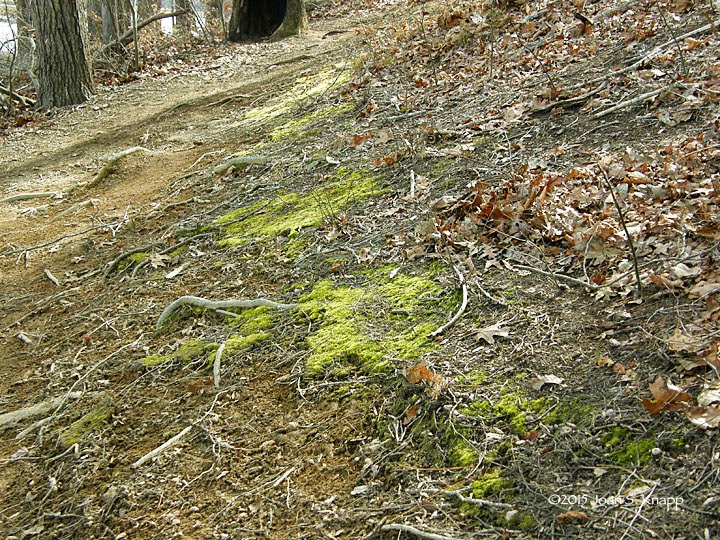February 6th. (Continued from…) I haven’t been to
Fort Yargo for a few years and decided to intersperse walks in the park with my
trike rides. In previous years, I’ve both walked some of the trails and rowed
the lake. If you know where to look, the park has quite a variety of
wildflowers.
I decided to walk from the Group Shelter A to the Old Fort
and back. There isn’t much in the way of plants at the moment but I enjoy the
scenery and this was a particularly pretty day.
Starting
back down the trail from the Old Fort. It’s fascinating how much darker this
section of trail looks walking it this way. Some of the darkness is due to
lighting; some of the darkness is attributable to the soot remaining on some of
the tree trunks from a controlled burn several years ago.
A
little further along the upper trail back to the Fishing Area
I
always check this tree. Cranefly Orchids grow in the shelter of the trunk of
the tree. These plants usually bloom. Even if I don’t see them in bloom, it’s
not unusual to see the empty seedpods in the fall.
Arriving
back at the Fishing Area.
The
Fishing Area parking lot
Back
to the bridge out of the Fishing Area.
An
American Beech tree in the woods.
The
trail just south of the Fishing Area. A couple of Pink Lady’s Slipper Orchids
(Cypripedium acaule) bloom just to the right side of the trail. I think most
people walk past them without even seeing them.
Nearby
are some Pipsissewa plants. These often bloom and set seeds.
Looking
south along the lake. I’d never thought much about it but these benches are
located at strategic intervals along the trail.
The
trails in the park are color coded; often the trails are marked on tree trunks.
Almost
back to the cliff.
Markers
are also placed at 1/10-mile intervals. I’m not sure if this is encouraging or
discouraging.
Looking
along the fence above the cliff.
Small
patches of moss above the trail.
Some
tree roots have been worn down over the years. It’s easy to trip on these roots
and nearby Lespedeza bushes (Lespedeza sp.) lie in wait to deposit seeds on
socks and pants if you do.
Just past this point, there’s a small open area that is overgrown at the moment but which probably be cleared in the spring. I’ve found Butterflypea (Centrosema virginianum), Perennial
Wildbean (Strophostyles umbellata) and Helmet Flower (Scutellaria integrifolia),
Hairy Angelica (Angelica venenosa) in
this open area.
The
park boasts a Disc Golf Course near the picnic area. This ‘hole’ is on the
trail.
Several Redring Milkweed (Asclepias variegata) plants grow at
the edge of the ‘fairway’ near this hole.
Tree
roots form steps along the trail back into the woods and the picnic area.
The
wildflowers that I’ve mentioned here are those that I remember clearly; there
are more. This walk can be rewarding at many times of the year.
Related
posts:



















No comments:
Post a Comment